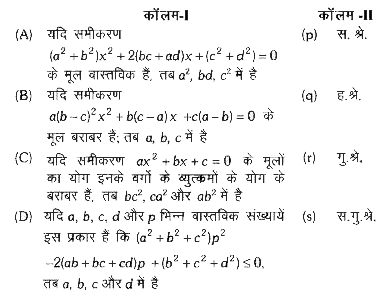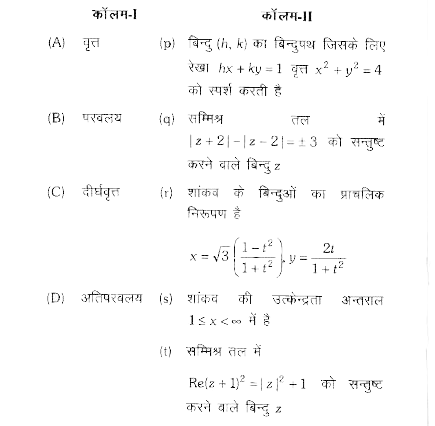θ के सभी मानों के लिए रेखाओं xcosθ+ysinθ=a तथा xsinθ−ycosθ=b के प्रतिच्छेद बिन्दु का बिन्दुपथ है
एक दीर्घवृत्त
एक वृत्त
एक परवलय
एक अतिपरवलय
The correct Answer is:B
Step by step video, text & image solution for theta के सभी मानों के लिए रेखाओं x cos theta +y sin theta=a तथा x sin theta - y cos theta =b के प्रतिच्छेद बिन्दु का बिन्दुपथ है by Maths experts to help you in doubts & scoring excellent marks in Class 12 exams.
Updated on:21/07/2023Topper's Solved these Questions
- वृत्त तथा वृत्तों का निकाय BOOK - ERRORLESS HINDICHAPTER - वृत्त तथा वृत्तों का निकाय EXERCISE - JEE Advanced (Integer type questions)
20 Videos
- वृत्त तथा वृत्तों का निकाय BOOK - ERRORLESS HINDICHAPTER - वृत्त तथा वृत्तों का निकाय EXERCISE - JEE Advanced (Matrix Match type questions)
8 Videos
- वर्ग समीकरण एवं असमिकायें BOOK - ERRORLESS HINDICHAPTER - वर्ग समीकरण एवं असमिकायें EXERCISE - JEE Advanced (Matrix Match type questions)
2 Videos
- शांकव परिच्छेद BOOK - ERRORLESS HINDICHAPTER - शांकव परिच्छेद EXERCISE - JEE Advanced (Matrix Match type questions)
7 Videos
Similar Questions
रेखा 2x−3y=1 वृत्तीय क्षेत्र x2+y2≤6 को दो भागों में विभाजित करती है। यदि
S={(2,34),(52,34),(14,−14),(18,14)}, तो S में स्थित उन बिन्दुओं की संख्या जो लघुत्तर भाग में अन्दर है, निम्न है
View Solutionकॉलम I में दिए गए वक्त्तव्यों का कॉलम II में दिए गए गुणधर्मों से सुमेल करें

View Solution
View Solution
View SolutionIf x(cos theta)/(a)+y(sin theta)/(b)=1 and x(sin theta)/(a)-y(sin theta)/(b)=1 then
View SolutionThe normal to the curve x=a(cos theta + theta sin theta), y=a(sin theta - theta cos theta) at any theta is such that
View Solutionif θ is a parameter then x=a(sinθ+cosθ),
y=b(sinθ−cosθ) respresents
View SolutionIf xcosθ+ysinθ=a,xsinθ−ycosθ=b then
View SolutionIf xacosθ+ybsinθ=1,xasinθ−ybcosθ=1 then
View SolutionEliminate θ:x=a(cosθ+cos2θ),y=b(sinθ+sin2θ).
View SolutionIf sinθx=cosθy then sinθ−cosθ
View Solution3cosθ+5sin(θ−π6) का θ के किसी भी वास्तविक मान के लिए अधिकतम मान है
View SolutionIf x sin^3 theta + y cos ^3 theta = cos theta sin theta And x sin theta = y cos theta If so
View SolutionThe normal to the curve x=a(cos theta + theta sin theta), y=a(sin theta - theta cos theta) at any theta is such that
View SolutionIf theta is a parameter then x=a(sinθ+cosθ)y=b(sinθ−cosθ) represents,
View SolutionThe normal to the curve x=a(cos theta + theta sin theta), y=a(sin theta - theta cos theta) at any theta is such that
View Solution
